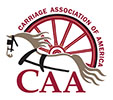
A. Although English carriage makers continued to cover carriage roofs with leather, in America cotton fabrics were used at least as early as 1880. This is how it was done. The roof was covered with boards of whitewood or pine and, on the best work, these boards had canvas or burlap glued tightly to them on the inside to prevent splitting. This was done with most carriage panels. When fixed in place the top surface of the roof was leveled and sand-papered smooth.
For low-priced work, the surface of the wood was then given two coats of primer paint and covered with rubber-coated cloth, the edges of which were secured with wood molding.
For the better class of carriages, the sand-papered surface was covered with glue and fine muslin, also soaked in glue, was stretched over. When dry, this surface was sand-papered and given two coats of white lead paint. Another heavy coat of paint was then applied and, while wet, sail cloth or canvas was laid on and stretched and rubbed into place. The canvas was secured round the edges with wood molding, and then filled with roughstuff, or filler, and painted like other parts of the carriage.
If your carriage has been covered with rubber-coated cloth this should be easy to remove as it is not likely to have been heavily glued. If it has been covered with muslin and sail cloth, and then painted several times, you must first remove the moldings, then take off all the cloth and paint. This might be done with a blow torch with may soften both the glue and the paint all together.
When you have got all the covering material off the wood, you should examine it carefully both inside and out. If water has been leaking in for some times, then parts may be rotted. It is likely that the boards will have shrunk and the joints will have opened. All this has to be made good; part or all of some boards may have to be replaced and you may have to rabbet strips of wood along the joints when the woodwork has been made sound and smoothed off with sand-paper, you can proceed to apply muslin and duck or canvas as described above. If you prefer to use a modern waterproof plastic coat cloth, you must be certain that it can be stretched down tight. It would also be best if ti would take paint.
S.R.H.
From The Carriage Journal, Vol 31, No 3, Winter 1984
